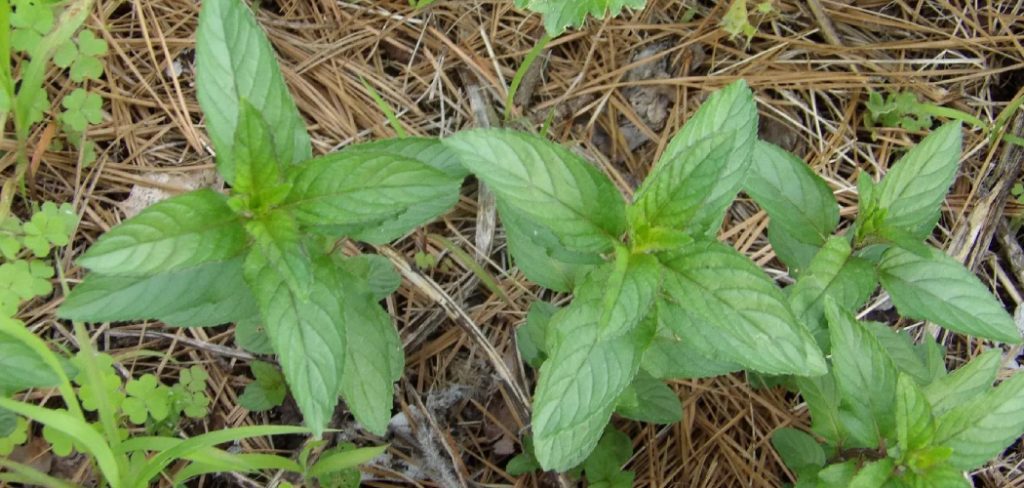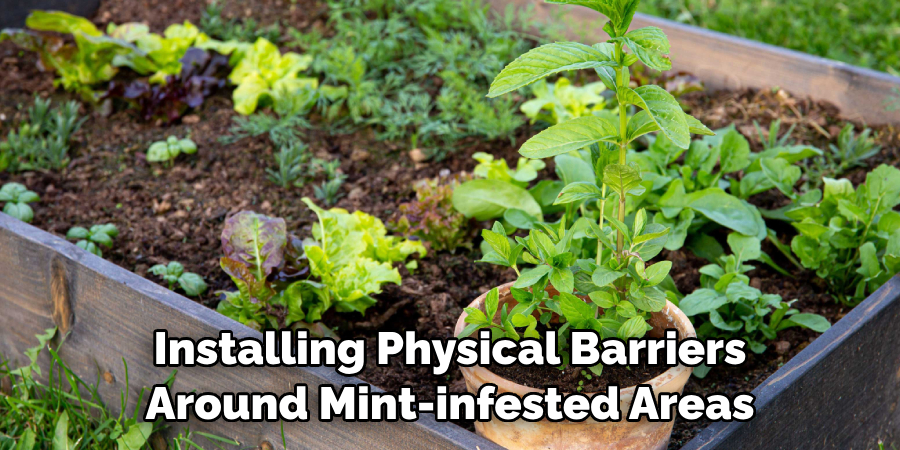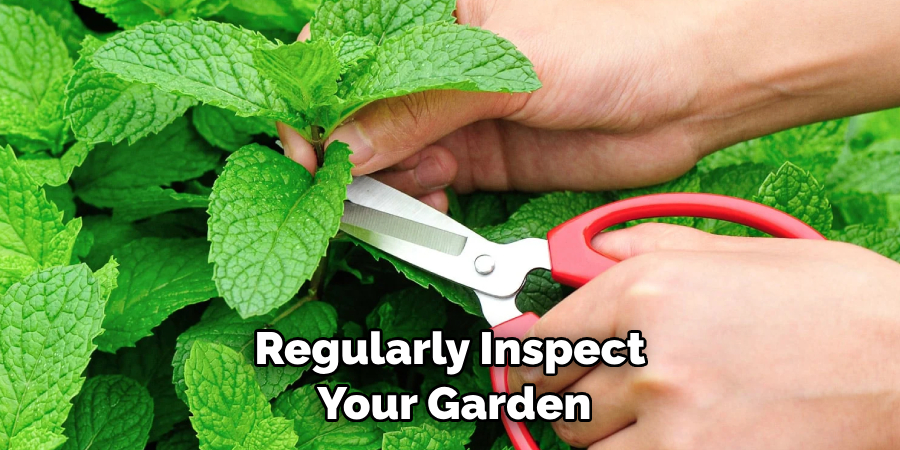To get rid of mint in the garden, you can manually pull out the plants and their roots.

Why Mint Is A Problem In Your Garden
Mint can be quite problematic in your garden due to its invasive nature. This herb has a tendency to spread rapidly and take over the surrounding plants. Its aggressive growth can choke out other vegetation and monopolize the soil’s nutrients.
The effects of mint on neighboring plants can be detrimental, hindering their growth and survival. The vigorous spreading of mint can also make it difficult to control and eliminate from the garden. Additionally, its strong scent can deter beneficial insects, which can disrupt the overall balance of your garden ecosystem.
To get rid of mint in your garden, it is important to understand its invasive tendencies and take proactive measures to prevent its spread.
How to Get Rid of Mint in the Garden: Step by Step Guide
Identifying Mint In Your Garden
Mint can be a stubborn plant to remove from your garden, but with the right techniques, you can get rid of it successfully. One of the first steps is to accurately identify the mint in your garden. Mint plants typically have visual characteristics such as square stems and opposite leaves.
Additionally, they often have a strong aroma, especially when the leaves are crushed. There are several common types of mint that you may find in your garden, including peppermint, spearmint, and chocolate mint. Each of these varieties has its own unique characteristics, such as leaf shape and color.
By familiarizing yourself with these visual cues, you can easily identify and remove the mint plants from your garden, ensuring that they don’t take over your other plants.
Methods To Remove Mint From Your Garden
To remove mint from your garden, manual removal is an effective method. Pull the plants carefully, making sure to remove the roots. Another option is to use herbicides specifically designed for mint control. Apply the herbicide according to the product instructions, being cautious not to harm other plants.
If you prefer natural remedies, there are a few options to suppress mint growth. One method is to cover the area with mulch, which will smother the mint and prevent it from spreading. You can also try spraying a mixture of vinegar and water directly on the mint plants.
This natural herbicide can help inhibit their growth. By using these methods, you can effectively get rid of mint from your garden and maintain a clean and thriving outdoor space.
Creating Barriers To Prevent Mint Spread
Creating barriers to prevent mint spread in your garden can be a highly effective strategy. Installing physical barriers around mint-infested areas is one way to limit its growth. Underground root barriers are especially useful for containing mint, as they restrict the spread of its extensive rhizomes.

By installing these barriers, you can prevent mint from taking over your garden and encroaching on other plants. Remember to regularly monitor and maintain the barriers to ensure they remain intact and functional. With proper barrier installation, you can successfully keep mint in control and enjoy a well-maintained garden.
Say goodbye to the nuisance of overly aggressive mint and reclaim your garden space with this simple solution.
Managing Mint With Companion Planting
Companion planting is a beneficial method to manage mint growth in your garden. By choosing compatible plants, you can deter the spread of mint. Mint has a tendency to take over garden beds, but with strategic companion planting, you can control its growth.
By pairing mint with plants that have strong scents, such as citronella or lavender, you can help repel the mint and keep it from spreading uncontrollably. Additionally, plants like marigolds and petunias can act as barriers, preventing the mint from encroaching on other areas of your garden.
Overall, companion planting offers a natural and effective way to get rid of mint without using harsh chemicals or resorting to extreme measures.
Maintaining Healthy Soil To Prevent Mint Growth
Maintaining healthy soil is crucial in preventing the growth of mint in your garden. One effective method is proper soil preparation, which involves regular testing and amendment techniques. By understanding the composition of your soil through testing, you can identify any deficiencies that may promote mint growth.
Adding amendments such as organic matter, compost, and balanced fertilizers can improve soil structure and nutrient availability, making it less favorable for mint to thrive. Additionally, ensuring proper drainage and moisture levels in the soil can discourage mint from spreading.
So, before planting your garden, take the time to prepare the soil adequately to create an environment inhospitable to mint growth. By doing so, you can maintain a mint-free garden and ensure the health and productivity of your plants.
Preventing Mint From Reestablishing In Your Garden
Regular monitoring and prompt removal of any mint resurgence are essential to prevent its reestablishment in your garden. By staying vigilant, you can ensure that any new growth of mint is promptly dealt with. Additionally, when introducing new plants or soil to your garden, it is crucial to ensure they are free from mint to prevent its spread.

Regularly inspect your garden for any signs of mint, such as shoots or leaves, and remove them as soon as possible. This proactive approach will help keep your garden mint-free and maintain the health of your other plants. Remember to be diligent and thorough in your monitoring to successfully eradicate mint from your garden.
With these measures in place, you can enjoy a mint-free garden without the hassle of its invasive growth.
Alternative Uses For Mint
Mint, though a delightful addition to the garden, can sometimes become a nuisance. Instead of throwing it away, consider alternative uses for mint. Harvesting and utilizing mint for culinary purposes is one such option. With its refreshing aroma and unique flavor, mint can lend a refreshing twist to both sweet and savory dishes.
From salads and cocktails to desserts and sauces, the culinary possibilities are endless. Mint can also be dried and preserved for future use, ensuring a steady supply throughout the year. Additionally, think outside the garden and explore creative ways to incorporate mint in non-garden areas.
Infuse mint leaves into homemade bath and beauty products, mix them into homemade cleaning solutions, or even create mint-scented sachets for your home. With a bit of creativity, you can make the most of your mint harvest and enjoy its many benefits beyond the garden.
Frequently Asked Questions Of How To Get Rid Of Mint In The Garden
How Do I Get Rid Of Mint Naturally?
To get rid of mint naturally, you can try pulling it out by the roots or using boiling water to kill it. Alternatively, you can use vinegar or a mixture of dish soap and water to spray the mint leaves and prevent it from growing back.
Can I Use Chemicals To Remove Mint From My Garden?
Yes, you can use chemical herbicides like glyphosate to eliminate mint from your garden. However, it’s important to follow the instructions carefully and avoid using it near other plants or bodies of water. Always consider natural alternatives before resorting to chemical solutions.
Will Removing Mint Harm Other Plants In My Garden?
Removing mint should not harm other plants in your garden, as long as you are careful during the removal process. Make sure to avoid uprooting or damaging nearby plants and be cautious when using any chemicals, as they may affect other plants if not used properly.
Conclusion
To sum up, tackling an invasion of mint in your garden may seem like a daunting task, but with the right strategies, it can be effectively managed. Start by identifying the mint plants and removing them manually, ensuring you dig up their roots as well.
Consider using barriers and containers to prevent the spread of mint and regularly prune to keep it in check. Natural remedies like vinegar or boiling water can be used to suppress mint growth, while herbicides should be used with caution.
By following these steps and being consistent in your maintenance efforts, you can successfully get rid of mint in your garden and reclaim control over your plants. Remember, persistence is key when it comes to keeping your garden free from invasions!
